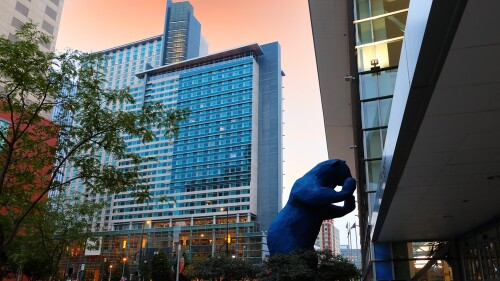For Ryan Gravel—an urban planner by training who initially proposed the concept of the BeltLine in his Georgia Tech master’s thesis and is now an author and urban design consultant—urban infrastructure can serve as a metaphor for an entire culture. Ultimately, he said, it succeeds best when it brings people together, in both its creation and how it is used. But city leaders need to think bigger about the implications of infrastructure projects of all sizes.
“The story of people can be told through infrastructure,” said Gravel, a ULI member who spoke at 2017 Carolinas Meeting in Charlotte in March. His 2016 book, Where We Want to Live, outlines American infrastructure trends and the development of the BeltLine. “Our culture shapes our infrastructure, which changes how we see the world.”
His own life, he explained, was shaped by urban planning and transportation patterns. A child of the Atlanta suburbs, he spent a year in Paris in his 20s, where he lost 20 pounds (9 kg) largely because of all the walking he was forced to do in that pedestrian-friendly city. “It wasn’t just infrastructure—it created a way of life, a foundation for an economy, a culture, a social life,” he explained.
That experience deeply affected his view of cities and their possibilities. He returned to Atlanta and began examining the consequences of the car-centric lifestyle that had been created there. In 1999, Gravel’s graduate thesis for his master’s degree in architecture and city planning from Georgia Tech was a plan to convert a 22-mile (35 km) loop of abandoned railway lines that circled downtown Atlanta into a walkable and transit-oriented corridor.
He never thought it would go anywhere. But two years later, while working for a local architecture firm, Gravel submitted the plan to city council member Cathy Woolard, who fell hard for it. Together, the two began talking up the concept and its transit, economic development, environmental, and cultural implications.
People responded. “There was an unbelievable movement of people who believed in it,” said Gravel. The railway line ran through 45 diverse neighborhoods, and residents from a wide range of socioeconomic groups and ethnicities were enthusiastic—as were nonprofit organizations and many members of Atlanta’s business community.
That broad base, said Gravel, was key to the project’s success. Not only did he and Woolard have deep community buy-in, but each local actor also provided something unique that shaped and expanded the concept.
Residents saw the plan as a way to harness Atlanta’s rapid growth and strengthen the city’s quality of life—and they were able to create their own pet projects, like farmers markets, bocce ball courts, and a Lantern Parade that grew from 200 participants in 2010 to 75,000 this past year. In turn, local and national organizations like Park Pride and the Trust for Public Land recognized that the BeltLine aligned with their missions, and they helped increase the project’s parklands; meanwhile, philanthropic groups like the Arthur M. Blank Family Foundation helped fund the concept.
And, said Gravel, “when the business community saw potential, that gave it a lot of legs. You can’t build an almost $4 billion project with just the grassroots. Without [development] along the path, there’s no life.”
The result is one of the biggest U.S. urban redevelopment projects. Only about five miles (8 km) of trail are complete at present, but that section of the trail is wildly popular, said Gravel. Construction on transit is beginning soon, and by 2030, the BeltLine is slated to include 22 miles (35 km) of streetcar tracks, a 33-mile (53 km) network of trails, 1,400 acres (566 ha) of new parks carved out of old industrial lands, and up to $20 billion in total estimated economic development. Just a couple of weeks ago, an $80 million mixed-use development was announced along the completed section of the trail.
It is a different way of building infrastructure, and a different way of interacting with the city, said Gravel. “The intention is to change the shape of our lives to something more sustainable. It’s already radically changing our world.”
Of course, that new perspective on infrastructure’s potential is not limited to Atlanta. All over the United States, cities are boasting ambitious urban infrastructure makeovers that Gravel believes will fundamentally transform their built environments, “just like sprawl did.” They include the High Line in New York City, Philadelphia’s three-mile (5 km) Rail Park through Center City, and the restoration of the Los Angeles River.
But these projects often share a complicating factor: their popularity can drive up housing costs and displace longtime residents and businesses. “You can’t call it a success without focusing on affordability,” Gravel said. In Atlanta, “the real challenge now is that post-recession growth in the city is exciting and really powerful, and it’s making a lot of us nervous about affordability.”
The BeltLine received funding as part of a tax allocation district, 15 percent of which was earmarked for affordable housing. That amounts to roughly 5,600 units. “At the end of the day, it’s a drop in the bucket” relative to Atlanta’s needs, said Gravel. Still, he said, the answer is not to pull back on the project and its ambitions; the answer must come in the form of new financial tools.
Another answer is to begin to think bigger about giant infrastructure projects. “We should start asking more questions about what we build,” said Gravel. With big highway projects, for example, “there’s no discussion about affordability, or who loses and who benefits, or environmental sustainability. Cities that are successful will think about that, but it’s a big shift: it’ll take a long time.”







